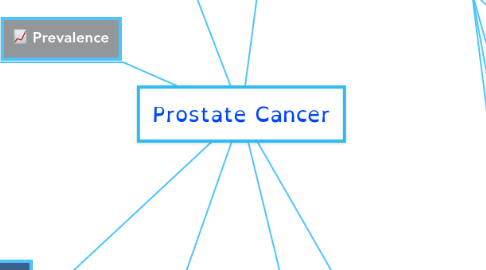
1. Pathophysiology
1.1. Develops in an androgen-dependent environment
1.1.1. Androgen hormones in men include testosterone and dihydrotestosterone (DHT)
1.1.2. Androgens are produced in the testes and prostate
1.2. Majority of tumors are adenocarcinomas
1.3. Often a slow growing cancer
2. Prevalence
2.1. Most commonly diagnosed non-skin cancer in men in the U.S.
2.1.1. Rare before age 50
2.1.2. > 75% of men diagnosed are over age 65
2.2. Lifetime risk for diagnosis >15%
2.2.1. Most cases have a good prognosis even without treatment
2.2.2. Lifetime risk of dying is 2.8%
2.3. Second most frequently diagnosed cancer
2.4. Sixth leading cause of death worldwide
3. Clinical Manifestations
3.1. Often no symptoms until it is advanced
3.1.1. Late or advanced symptoms include bone pain and fractures due to metastasis, lower extremity edema, enlarged lymph nodes, enlarged liver, mental confusion with brain metastasis
3.2. Bladder outlet obstruction: slow urine stream, hesitancy, incomplete emptying, frequency, nocturia, dysuria
4. Causes
4.1. Chronic Inflammation
4.1.1. BPH progression and acute urinary retention
4.2. Genetics
4.2.1. May be responsible for 5%-10% of prostate cancers
4.2.1.1. 1 first degree relative = 2 x the risk, 2 first degree relatives = 5 x the risk
4.2.2. Mutations in the BRCA 1 and 2 genes are associated with aggressive disease and poor outcomes
4.2.2.1. BRCA 2 presents the highest risk
4.2.2.2. Men with this mutation's risk of prostate cancer increases 20 times
4.2.3. Hypermethylation of the GST-P1 gene
4.3. Variations in other genes with inflammatory pathways are linked to the development of prostate cnacer
5. Treatment: 7 standard treatment options
5.1. Watchful Waiting/Active Surveillance
5.1.1. Used for older men who are asymptomatic or who were diagnosed during a screening
5.2. Surgery
5.2.1. 1) Radical Prostatectomy 2) Retropubic Prostatectomy 3) Perineal Prostatectomy 4) Pelvic Lymphadenectomy 5) Transurethral resection of the prostate (TURP)
5.3. Radiation Therapy/Radiopharmaceutical Therapy
5.3.1. High-energy x-rays or other forms of radiation to kill cancer cells or keep them from growing
5.4. Hormone Therapy
5.4.1. Removes/blocks hormones to prevent cancer cells from growing. Includes Abiraterone acetate, orchiectomy, estrogens, Luteinizing hormone-releasing hormone agonists, and antiandrogens
5.5. Chemotherapy
5.6. Biologic Therapy
5.6.1. Uses patient's immune system to fight cancer
5.7. Bisphosphonate Therapy
5.7.1. Reduce bone disease when cancer has spread to the bone
6. Risk Factors
6.1. African-American men are 73% more likely to be diagnosed than caucasian men
6.2. High calcium intake
6.3. Tall height
6.4. Agent Orange exposure
7. Diagnostic Testing
7.1. Prostate Specific Antigen Screening (PSA)
7.1.1. Free PSA Test
7.1.1.1. < 25% Free PSA = greatere risk of getting cancer
7.1.2. PSA Velocity: Rate of rise over time
7.1.2.1. Faster increase = more risk
7.1.3. PSA Density: PSA per volume of prostate
7.1.3.1. Higher density = more risk
7.1.4. Urinary PCA3 Test

